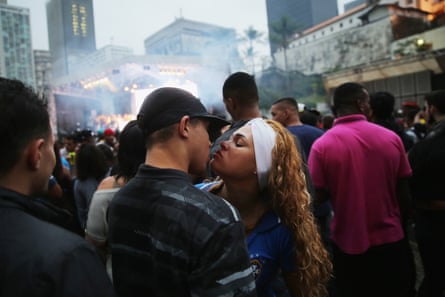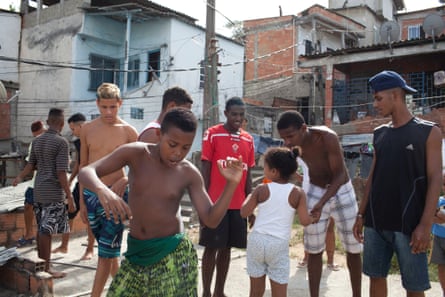Harsh, thunderous kicks; offbeat, crispy cymbals; powerful – sometimes incomprehensible – vocals, all preferably blasted out of sturdy speakers. This is the sound of baile funk, an electronic music born 40 years ago the favelas of Rio de Janeiro, Brazil, and one of the most thrilling and downright weird sounds to ever cross into mainstream culture.
Although it has been widely adopted in Brazil for some time, it has recently extended beyond the country’s borders, becoming a popular subject in memes, fashion events, and the current English-speaking pop culture. This year, Cardi B and Travis Scott have incorporated it into their work. There is also a new trend known as bruxaria, meaning witchcraft, which is a darker, four-on-the-floor style that originated in the fluxos (parties) of São Paulo’s favelas (low-income neighborhoods). These parties feature loud music blasting from car sound systems throughout the narrow streets all night long. Bruxaria has gained popularity outside of Brazil as well, leading to the emergence of phonk: an internet-based genre that exaggerates and refines the main characteristics of its predecessor. Phonk has exploded on popular platforms such as TikTok and Spotify, with over 7 million subscribers to the main phonk playlist on Spotify, making it one of the most popular playlists in the world.
According to Priscila Cavalcante, also known as House of Pris, baile funk is now a fundamental element in modern music, whether it is played in clubs or incorporated into other genres. She suggests that if music doesn’t have the essence of funk, it is missing a key ingredient.
Guilherme Galdino, a resident of São Paulo, was deeply captivated by the energetic and vibrant music style known as baile funk. This passion led him to become DJ Arana, a prominent figure in the bruxaria scene, alongside other notable producers such as DJ Patrick R, DJ Blakes, and DJ K. These producers often collaborate with popular MCs to create tracks that have gained widespread popularity. DJ Arana’s musical journey began with creating music on a Samsung Duos mobile phone, but now at 18 years old, he has amassed over 210 million views on his YouTube channel and has a monthly listenership of 7 million on Spotify. His music, which deviates from the stereotypical tropical sounds associated with Brazil, has a darker and more haunting tone. According to DJ Arana, his producer persona is like a character or a game skin, and he enjoys incorporating horror elements into his music to surprise and evoke strong reactions from his listeners.
The genre of Baile funk has sparked popular dance trends on the internet and is now making its way into clubs. Its fast-paced fusion of different styles has led it to be mixed with a variety of genres, including hard techno, reggaeton, and Afrobeats. DJ Arana has witnessed his music being played in various countries, from Japan to Switzerland.

When Cavalcante was in her twenties during the early 2000s, she faced a significantly different situation. She left Brazil to pursue a career in music in Europe. She settled in Amsterdam and began DJing 90s baile funk music. However, she found that people did not seem to enjoy this type of music, with only about ten people dancing at the clubs. Cavalcante had first fallen in love with baile funk while attending crowded free parties in her hometown of Fortaleza, located in the northeastern state of Ceará in Brazil. She recalls feeling emotional the first time she heard the hit track “It’s Automatic” by the American group Freestyle, which is very popular in Rio’s suburbs and frequently played on the radio and by top DJs.
In 1988, the song was featured on a compilation album by Furacão 2000, a popular baile funk group. These groups emerged in the 1970s, hosting parties in Black and favela communities with a soundtrack of funk music, including artists like James Brown and Brazil’s Tim Maia. Over time, baile funk evolved as it incorporated elements of Miami bass, New York freestyle, and Los Angeles electro, but the genre remained known by various names, such as funk carioca and favela funk.
During the 1990s, the fashion continued to change and gained attention as a cultural phenomenon in Rio, leading to increased scrutiny. The media and politicians often associated the scene with violence and drug trade. However, the catchy tamborzão, baile funk’s distinctive rhythm, spread beyond Rio and gained popularity in other Brazilian cities like Fortaleza, Recife, Belo Horizonte, São Paulo, and even internationally.
According to Cavalcante, in the mid-2000s there was a resurgence of baile funk, with MCs becoming the focal point instead of DJs. This was further popularized by German DJ Daniel Haaksman’s 2004 compilation Rio Baile Funk: Favela Booty Beats, which introduced the sound to a wider international audience. American DJ Diplo also played a significant role in championing the genre, incorporating baile funk into his productions with Brazilian musician Deize Tigrona, British rapper MIA, and Jamaican-American dance music trio Major Lazer. Beyoncé’s 2011 hit Run the World (Girls) was heavily influenced by baile funk, with its inspiration coming from Major Lazer’s 2009 song Pon De Floor.

Cavalcante has amassed a collection of almost a thousand baile funk vinyl records, and is now based in Miami, one of the main hubs for sounds that made up baile funk in the 80s. She has made a name for herself spinning early funk tracks that meld together Brazilian Portuguese vocals and Miami bass beats. “The first party we had here was crowded,” she says. “And we didn’t have an Instagram account whatsoever.”
The American music charts appear to be the next uncharted territory: Cardi B and Megan Thee Stallion’s “Bongos” or Travis Scott’s “K-pop” may not impress aficionados, but both songs are influenced by recent versions of baile funk. And then there’s Anitta, a pioneering Brazilian pop artist who started her career as a baile MC before achieving global fame.

Taísa Machado is a dancer, researcher, and one of the curators of the first major exhibit in Rio dedicated to baile funk at the Museu de Arte do Rio. She poses the question: “Are people abroad listening to Anitta? What type of funk do international DJs play? It’s all unclear now.” She reflects on the genre’s recent global success, stating “It’s almost like a ‘I told you so’ moment. But there’s also a sense of panic. Many are concerned that foreign artists will start making baile funk without collaborating with Brazilian artists. I worry that mainstream artists only scratch the surface of the genre, while underground artists don’t receive the recognition they deserve.”
Rennan da Penha, a prominent baile funk DJ in Rio with 1 million followers on Instagram, is currently leading a campaign against what he refers to as “TikTok baile funk”. He believes that tracks that are widely shared on the platform and spawn viral dance moves have no place in his packed parties. According to Machado, the rise of TikTok dance trends has caused several baile funk and passinho dancers to lose relevance to TikTok influencers. There is also a sense that, similar to the 90s and 00s, baile funk is not respected by high culture, as there are no funk artists nominated in the new best Portuguese-language urban performance category at the Latin Grammys this month.
However big baile funk gets internationally, Cavalcante hopes that “producers keep blending it with other genres like reggaeton and hip-hop – this is the kind of thing that brings energy to a genre so it becomes global,” she says. Machado also sees this culture-blending as important: “There are DJs and producers in Brazil crossing baile funk with house, Afrobeats, amapiano [South African dance music] – they have eyes wide open to what’s been on the rise internationally”.
However, for Machado, there is one unique factor that sets Brazilian baile funk artists apart and ensures the continued evolution of the genre: the baile funk street parties held in the favelas where the genre originated. These bailes were where Cavalcante and Arana were first exposed to the signature beats and vocals that now shape their lives. According to Machado, “Everything in baile funk originates from these parties. They are the birthplace of new trends. To create authentic baile funk music, one must have a connection to the favela. Funk is synonymous with favela life.”
Source: theguardian.com


